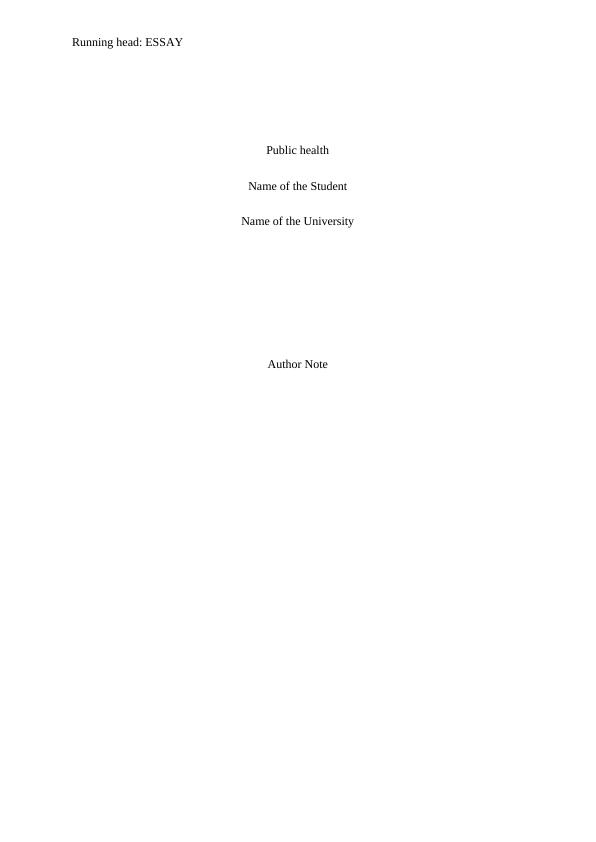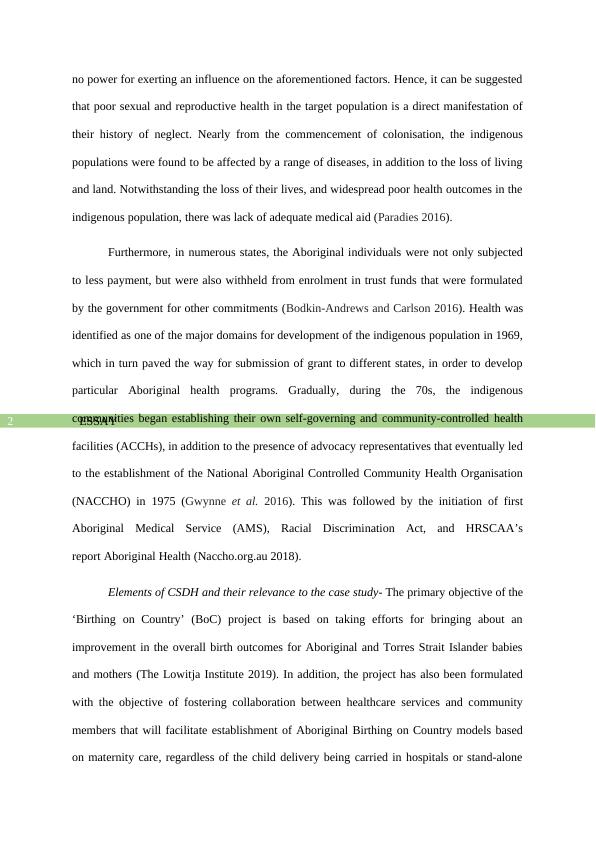Indigenous Health and the Birthing on Country Project: A Conceptual Framework for Action on Social Determinants of Health
Added on 2022-11-17
10 Pages2667 Words145 Views
Running head: ESSAY
Public health
Name of the Student
Name of the University
Author Note
Public health
Name of the Student
Name of the University
Author Note

ESSAY1
Introduction- Indigenous health is an umbrella term that generally refers to the
cultural, physical, emotional, and social wellbeing of Aboriginal and Torres Strait Islander
individuals (indigenous Australians). There is mounting evidence for the fact that numerous
indigenous Australians report inferior health outcomes, when compared to the non-
indigenous Australians, and also report increased rates of mortality younger ages (Willis,
Reynolds and Keleher 2016). Indigenous Australians also display an increased likelihood of
suffering from a plethora of disorders such as, mental health problems, respiratory diseases,
cardiovascular complication, diabetes mellitus, and chronic renal disease (Jamieson et al.
2016). Furthermore, there is a need to identify the reproductive and sexual health of
indigenous population, with a special emphasis on maternal health outcomes. It has often
been found that reproductive and sexual health of indigenous women is governed by the
cultural, socioeconomic, and political environment. This assignment will elaborate on the
conceptual framework for action on the social determinants of health, formulated by the
World Health Organization, in relation to a case study that focuses on the ‘Birthing on
Country Project’.
Historical perspective- The continuing predicament in relation to indigenous health
can be accredited to several generations of negligence and mistreatment, absence of any
unified public policy and failure of the government to create to provisions for adequate
resources, while ensuring that they are able to meet the health requirements of the
participants (Valeggia and Snodgrass 2015). The fundamental factors that are responsible for
poor indigenous health are typically accredited to the presence of economic or social
exclusion, low income, poor education, unemployment, poor sanitation, poor housing, and
absence of sufficient nutrition. Notwithstanding suffering from poor health conditions, when
compared to other Australians, the indigenous individuals usually report reduced access to
healthcare amenities (Short 2016). Historically, they have also been found to manifest little or
Introduction- Indigenous health is an umbrella term that generally refers to the
cultural, physical, emotional, and social wellbeing of Aboriginal and Torres Strait Islander
individuals (indigenous Australians). There is mounting evidence for the fact that numerous
indigenous Australians report inferior health outcomes, when compared to the non-
indigenous Australians, and also report increased rates of mortality younger ages (Willis,
Reynolds and Keleher 2016). Indigenous Australians also display an increased likelihood of
suffering from a plethora of disorders such as, mental health problems, respiratory diseases,
cardiovascular complication, diabetes mellitus, and chronic renal disease (Jamieson et al.
2016). Furthermore, there is a need to identify the reproductive and sexual health of
indigenous population, with a special emphasis on maternal health outcomes. It has often
been found that reproductive and sexual health of indigenous women is governed by the
cultural, socioeconomic, and political environment. This assignment will elaborate on the
conceptual framework for action on the social determinants of health, formulated by the
World Health Organization, in relation to a case study that focuses on the ‘Birthing on
Country Project’.
Historical perspective- The continuing predicament in relation to indigenous health
can be accredited to several generations of negligence and mistreatment, absence of any
unified public policy and failure of the government to create to provisions for adequate
resources, while ensuring that they are able to meet the health requirements of the
participants (Valeggia and Snodgrass 2015). The fundamental factors that are responsible for
poor indigenous health are typically accredited to the presence of economic or social
exclusion, low income, poor education, unemployment, poor sanitation, poor housing, and
absence of sufficient nutrition. Notwithstanding suffering from poor health conditions, when
compared to other Australians, the indigenous individuals usually report reduced access to
healthcare amenities (Short 2016). Historically, they have also been found to manifest little or

ESSAY2
no power for exerting an influence on the aforementioned factors. Hence, it can be suggested
that poor sexual and reproductive health in the target population is a direct manifestation of
their history of neglect. Nearly from the commencement of colonisation, the indigenous
populations were found to be affected by a range of diseases, in addition to the loss of living
and land. Notwithstanding the loss of their lives, and widespread poor health outcomes in the
indigenous population, there was lack of adequate medical aid (Paradies 2016).
Furthermore, in numerous states, the Aboriginal individuals were not only subjected
to less payment, but were also withheld from enrolment in trust funds that were formulated
by the government for other commitments (Bodkin-Andrews and Carlson 2016). Health was
identified as one of the major domains for development of the indigenous population in 1969,
which in turn paved the way for submission of grant to different states, in order to develop
particular Aboriginal health programs. Gradually, during the 70s, the indigenous
communities began establishing their own self-governing and community-controlled health
facilities (ACCHs), in addition to the presence of advocacy representatives that eventually led
to the establishment of the National Aboriginal Controlled Community Health Organisation
(NACCHO) in 1975 (Gwynne et al. 2016). This was followed by the initiation of first
Aboriginal Medical Service (AMS), Racial Discrimination Act, and HRSCAA’s
report Aboriginal Health (Naccho.org.au 2018).
Elements of CSDH and their relevance to the case study- The primary objective of the
‘Birthing on Country’ (BoC) project is based on taking efforts for bringing about an
improvement in the overall birth outcomes for Aboriginal and Torres Strait Islander babies
and mothers (The Lowitja Institute 2019). In addition, the project has also been formulated
with the objective of fostering collaboration between healthcare services and community
members that will facilitate establishment of Aboriginal Birthing on Country models based
on maternity care, regardless of the child delivery being carried in hospitals or stand-alone
no power for exerting an influence on the aforementioned factors. Hence, it can be suggested
that poor sexual and reproductive health in the target population is a direct manifestation of
their history of neglect. Nearly from the commencement of colonisation, the indigenous
populations were found to be affected by a range of diseases, in addition to the loss of living
and land. Notwithstanding the loss of their lives, and widespread poor health outcomes in the
indigenous population, there was lack of adequate medical aid (Paradies 2016).
Furthermore, in numerous states, the Aboriginal individuals were not only subjected
to less payment, but were also withheld from enrolment in trust funds that were formulated
by the government for other commitments (Bodkin-Andrews and Carlson 2016). Health was
identified as one of the major domains for development of the indigenous population in 1969,
which in turn paved the way for submission of grant to different states, in order to develop
particular Aboriginal health programs. Gradually, during the 70s, the indigenous
communities began establishing their own self-governing and community-controlled health
facilities (ACCHs), in addition to the presence of advocacy representatives that eventually led
to the establishment of the National Aboriginal Controlled Community Health Organisation
(NACCHO) in 1975 (Gwynne et al. 2016). This was followed by the initiation of first
Aboriginal Medical Service (AMS), Racial Discrimination Act, and HRSCAA’s
report Aboriginal Health (Naccho.org.au 2018).
Elements of CSDH and their relevance to the case study- The primary objective of the
‘Birthing on Country’ (BoC) project is based on taking efforts for bringing about an
improvement in the overall birth outcomes for Aboriginal and Torres Strait Islander babies
and mothers (The Lowitja Institute 2019). In addition, the project has also been formulated
with the objective of fostering collaboration between healthcare services and community
members that will facilitate establishment of Aboriginal Birthing on Country models based
on maternity care, regardless of the child delivery being carried in hospitals or stand-alone

End of preview
Want to access all the pages? Upload your documents or become a member.
Related Documents
Indigenous Health Perspectivelg...
|8
|2034
|70
Contemporary Indigenous Health and Well-being | Essaylg...
|8
|2220
|524
HEALTH STATUS BETWEEN INDIGENOUS AND REFUGEES PEOPLE IN AUSTRALIA ARTICLE 2022lg...
|12
|3147
|24
CAUSE OF POOR HEALTH AMONG THE ABORIGINAL PEOPLE.lg...
|4
|457
|360
Social Determinants of Health (SDOH) in Australialg...
|16
|3844
|153
Comparison of Indigenous Children's Access to Healthcare in Australia and Canadalg...
|15
|4371
|237